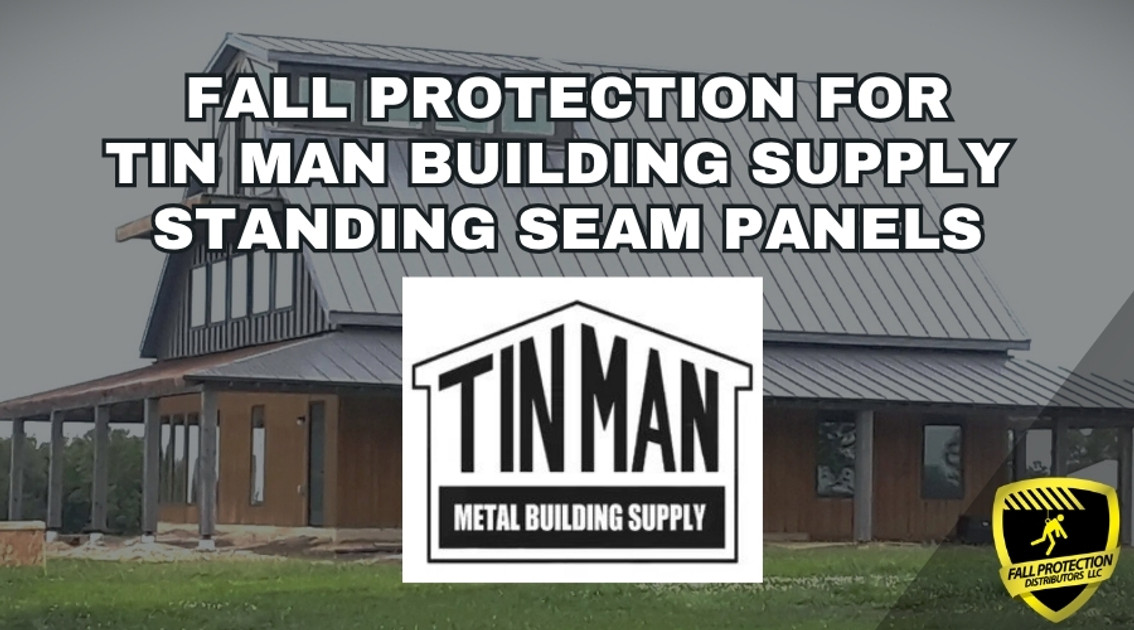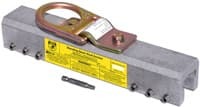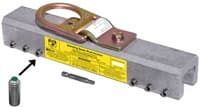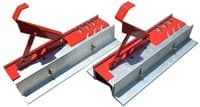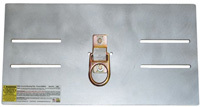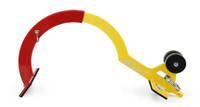Fall Protection For Tin-Man Metal Building Supply
Posted by Howie Scarboro - CEO Fall Protection Distributors, LLC on Jun 13th 2025
See the Roof Anchor Compatibility Chart for Tin-Man Metal Building Supply Standing Seam Panels.

Who Is Tin-Man Metal Building Supply?
Tin-Man combines trusted metal building products with hands-on service to support projects across the Kansas City region.
For over 25 years, Tin-Man Metal Building Supply has been a go-to resource for contractors, homeowners, and builders throughout the Kansas City metropolitan area. Based in Raytown, Missouri, and owned by Andrew Thomas, Tin-Man offers more than just quality metal components—it delivers end-to-end building solutions tailored for real-world job sites.
Tin Man offers a complete line of standing seam roofing, architectural trim, gutters, soffit panels, skylights, and insulation. Their crew doesn't stop at supply—they offer complete installation, project consultation, plan take-offs, job site prep, and final walkthroughs. That kind of full-service experience is rare, especially in the metal building world, and it keeps customers coming back for project after project.
As an authorized distributor for several well-known metal roofing and siding manufacturers, Tin-Man supports everything from custom homes and pole barns to large-scale commercial construction. Their standing seam systems offer long-term durability, clean aesthetics, and energy efficiency—and with Tin-Man's team on the job, you're getting more than materials. You're getting a partner with the tools and knowledge to help you build it right the first time.
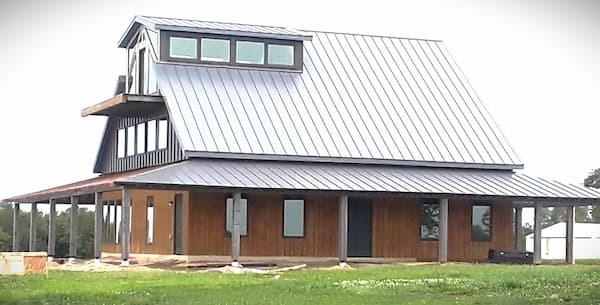
Why Is Fall Protection Anchor Design Critical for Standing Seam Roofs?
The wrong anchor can ruin your panels—non-penetrating systems are the innovative, safe solution for seam-style metal roofs.
Standing seam metal roofs are a premium roofing type with sleek, watertight designs that withstand movement and weathering. That's right—move. Panel expansion and contraction are possible due to the concealed clips and floating seams. But here's the catch: if you fasten a fall protection anchor directly through the panel, you've just turned a precision roof system into a ticking time bomb.
Standard screw-down anchors may be suitable for shingle or exposed-fastener metal roofs. Still, they can spell disaster on standing seam roofs. One wrong move can void the panel warranty, create a future leak path, or deform the seam to the point where you compromise its strength. We've seen roofs get patched, replaced, or completely ripped off because someone tried to save time with a screw gun and an incompatible anchor.
That's why seam-mounted, non-penetrating fall protection systems—like the SSRA1 Seam Anchor and its accessories—are essential. These anchors clamp securely onto the raised seam using set screws that grip without piercing the metal. There are no damage or warranty issues—just a solid OSHA-compliant tie-off point protecting your crew and the roof beneath them.
For Tin-Man customers installing standing seam systems, choosing the proper fall protection setup isn't just about meeting the code—it's about long-term roof health. Whether you're working on a snap-lock profile, mechanical seam, or architectural panel, there's a safe and compatible fall protection method that won't compromise your investment or put your workers at risk.
Curved Roof Panels
Curved panels are impressive but require expert fall protection planning before anyone sets foot on the roof.
See the Roof Anchor Compatibility Chart for Tin-Man Metal Building Supply Curved Standing Seam Panels.
Curved standing seam roofs make a bold architectural statement and introduce various safety complexities. These panels often require job-specific roll forming and bend techniques that alter the seam geometry, making most seam-mounted or ridge-based anchors ineffective or unsafe.
Neither the SSRA1 Anchor system nor the Ridge Pro Steep Assist is compatible with curved or radiused panels. In such cases, we recommend conducting an on-site inspection by a trained fall protection expert before installation. The right solution may involve specialty anchors, scaffolding, or perimeter guardrails—but whatever it is, the guesswork has no place on a roof this complex. Always confirm panel specs and safety compatibility before your crew climbs a ladder.
ABC Nailstrip Snap-Lock

ABC's Nailstrip Snap-lock panel combines sleek concealed-fastener aesthetics with quick installation, making it a popular choice for residential and light commercial roofing.
See the Roof Anchor Compatibility Chart for Tin-Man Metal Building Supply ABC Nailstrip Snap-Lock Standing Seam Panels.
The ABC Nailstrip Snap-lock panel system offers a modern appearance and straightforward installation, utilizing concealed fasteners that accommodate thermal expansion and contraction. This architectural panel is available in standard widths of 12 and 16 inches, with a 1-inch seam height, and made from 24-gauge or 26-gauge steel. Each panel is roll-formed for consistency and durability, with finish options including MS Colorfast 45®, MS Crinkle Finish, PVDF/FEVE coatings, and Acrylic Coated Galvalume for long-term weather protection and color retention.
Its simple snap-together design eliminates the need for specialized seaming tools. It makes it ideal for installers looking for both speed and structural performance. However, due to variations in seam geometry across manufacturers and job site conditions, not all nail Strip-style panels are suitable for clamp-on fall protection equipment. Always perform a test fit before arriving at the job site to ensure the seam profile can accommodate torque-rated set screws without slipping or deformation.
Fall Protection For ABC Nailstrip Snap-Lock
With the proper setup, you can protect both your workers and the integrity of your Nailstrip roof without driving a single screw.
When working on 24-gauge steel versions of the ABC Nailstrip Snap-lock panel, several OSHA-compliant fall protection products are compatible. They can create a safe and efficient job site without puncturing the panel.
Start with the SSRA1 Seam Anchor, which clamps securely onto the standing seam without penetrating the metal. This anchor provides a strong, removable tie-off point that doesn't void panel warranties or compromise water resistance. It's ideal for workers using personal fall arrest systems such as harnesses, SRLs, or rope grabs.
To get more out of your SSRA1 anchor, add the SSRA2 Roof Jack Adapter on top. This combo creates a sturdy platform for mounting 10-foot walkboards, providing your crew with a safe way to move across steep or slippery roof surfaces. Roof jacks provide better footing and comfort, helping to distribute weight evenly along the seams and protect the roof.
For temporary horizontal lifeline setups, the SSRA3 Anchor Plate mounts to two SSRA1 Seam Anchors, allowing the installation of a 100-foot horizontal lifeline system—perfect for jobs that require multiple workers to stay tied off while moving laterally along the roof. This setup allows two workers maximum mobility on the roof while staying 100% tied off.
Suppose your project requires a permanent fall protection solution. In that case, the Super Anchor 120-foot Standing Seam Horizontal Lifeline Kit offers everything needed for a long-term, non-penetrating setup. This kit includes seam clamps, base plates with 5" risers, and a galvanized steel cable that supports multiple users across a full 120-foot span. The system is ideal for ongoing maintenance or service access on commercial and institutional buildings.
For 26-gauge panels or any material other than 24-gauge steel, the Ridge Pro Steep Assist Anchor is your safest choice. This peak-hooking system allows workers to reach the ridge, secure the anchor, and maintain 100% tie-off when their feet leave the ladder. Because the Ridge Pro doesn't rely on seam clamping, it works well with lighter gauge steel on 6:12 to 12:12 roofs.
1.75 Inch Standing Seam Snap-Lock

These architectural snap-lock panels have a 1-3/4-inch rib height and are available in 12—or 16-inch widths. They offer a clean, modern profile.
See the Roof Anchor Compatibility Chart for Tin-Man Metal Building Supply 1.75 Inch Snap-Lock Standing Seam Panels.
These panels, manufactured from 24—or 26-gauge steel, utilize a concealed fastener system that delivers visual appeal and long-term weather resistance. They are roll-formed and available in premium finishes, including MS Colorfast 45®, PVDF/FEVE, and acrylic-coated Galvalume. The higher seam height enhances strength and water resistance, making this feature a popular option for residential and light commercial metal roofing projects.
Fall Protection For 1.75 Inch Standing Seam Snap-Lock
When working on 24 gauge steel versions of this panel, contractors can safely use a full range of SSRA-compatible fall protection gear.
The SSRA1 Seam Anchors can be clamped directly onto the seams without penetrating the roof, preserving waterproofing and warranty coverage. Once workers have installed the SSRA1 Anchors, they can mount SSRA2 Adjustable Roof Jack Adapters on top to support 10-foot wooden walkboards, creating a stable working platform across the roof.
SSRA3 Anchor Plates can be mounted to the SSRA1 seam anchors, allowing for multiple worker tie-offs to support temporary 100-foot horizontal lifelines, thereby enabling OSHA-compliant safety without compromising the roofing system.
Suppose you're looking for a more permanent solution. In that case, the Super Anchor 120-foot Standing Seam Horizontal Lifeline Kit offers a complete, non-penetrating lifeline system. This kit includes four SSRA1 anchors, two SSRA3 anchor plates with risers, and 120 feet of galvanized cable—perfect for ongoing access on larger roofs.
For all other substrates, including 26 gauge steel or alternative finishes, we recommend the Ridge Pro Steep Assist for roofs pitched between 6/12 and 12/12. This non-penetrating tool hooks over the peak, allowing workers to maintain 100% tie-off while moving safely across steep roof surfaces.
2-Inch Batten Seam

This unique roll-formed standing seam panel features a batten cap design, a 1-7/8-inch seam height, and widths of 12, 16, and 18 inches.
See the Roof Anchor Compatibility Chart for Tin-Man Metal Building Supply 2-Inch Batten Standing Seam Panels.
Crafted from 24- or 26-gauge steel, the 2-inch Batten Seam panel features concealed fastening and interlocking seams designed to accommodate thermal expansion and contraction. These panels are made of high-performance finishes, providing excellent durability and UV resistance. The batten cap construction delivers a bold architectural look, commonly used in residential and commercial roofing, where aesthetics and performance are harmonious.
Fall Protection For 2-Inch Batten Seam
This panel's batten cap seam profile presents unique challenges in terms of fall protection.
Seam-mounted anchors, such as the SSRA1, are incompatible with batten seams, as the cap is not structurally sound and can shear off or slide under load, posing a serious risk to workers and equipment. Therefore, we strongly advise against using any clamp-on anchor system for this type of panel.
For crews working on 2-inch Batten Seam panels, the Ridge Pro Steep Assist provides a safe and effective tie-off solution on roofs with slopes ranging from 6/12 to 12/12. The Ridge Pro hooks securely over the roof's peak, providing a non-penetrating anchor point for workers climbing or moving across steep sections. It allows for 100% tie-off during roof access. It minimizes the risk of damaging the panel system or voiding the manufacturer's warranty.
2-Inch Standing Seam (SuperLok®)

This durable, mechanically seamed standing seam system features a tall 2-inch rib, exceptional wind uplift resistance, and flexible installation options.
See the Roof Anchor Compatibility Chart for Tin-Man Metal Building Supply 2-Inch SuperLok Standing Seam Panels.
SuperLok® is a high-performance vertical leg panel system available in 12-inch and 16-inch widths, engineered for use on low-slope roofs starting at just one-half inch per foot. It installs over open framing—such as purlins or bar joists—without requiring a solid deck. SuperLok panels are available in 22-gauge, 24-gauge, and 26-gauge steel, with finishes including Galvalume Plus and Signature coatings. SuperLok panels provide the strength, durability, and thermal flexibility to withstand extreme weather conditions.
Fall Protection For 2-Inch Standing Seam
The 22 and 24-gauge steel versions of the SuperLok panel, along with the SSRA1 Seam Anchors, provide a secure, non-penetrating connection directly to the panel's vertical leg.
These anchors form the foundation for an integrated fall protection system, allowing contractors to add SSRA2 Adjustable Roof Jack Adapters to mount ten-foot wooden walk boards securely above the roof surface—creating stable working platforms without compromising the seam.
To protect crews during extended work sessions or team-based operations, the SSRA3 Anchor Plates can be mounted on top of SSRA1 Anchors and used to support temporary 100-foot horizontal lifeline systems, ensuring continuous tie-off across a large area.
The Super Anchor 120-foot Permanent Standing Seam Horizontal Lifeline Kit is an excellent choice for longer-term access needs. This OSHA-compliant, non-penetrating system includes SSRA1 anchors, base plates, risers, and 120 feet of galvanized cable. It offers continuous, elevated fall protection for multiple workers—perfect for routine maintenance, inspections, or facility upgrades.
If you're working with panel material other than twenty-two or twenty-four gauge steel—such as 26-gauge steel, aluminum, or copper—the Ridge Pro Steep Assist is your go-to safety solution for roof pitches from 6/12 to 12/12. It hooks securely over the peak and allows workers to stay 100% tied off when they step off the ladder.
Mini-Batten Seam (Craftsman™ Series)

This snap-on batten panel system offers superior flexibility for complex roof transitions while maintaining a clean architectural aesthetic.
See the Roof Anchor Compatibility Chart for Tin-Man Metal Building Supply Mini-Batten Craftsman Series Standing Seam Panels.
The Craftsman Series features separate pan and batten pieces, allowing installers to manage slope changes—from the roof to the fascia to the soffit—with a single continuous run. Available in 12-inch and 16.5-inch coverage widths, this system requires a solid waterproofed substrate and a minimum slope of 3:12 for effective water shedding. Commonly used on roofs and mansards, the system utilizes a concealed clip to secure each batten to the panel, allowing for movement to accommodate thermal expansion and contraction. Craftsman panels are available in 22, 24, and 26 gauge steel, with smooth or embossed finishes and high-performance coatings such as Galvalume Plus and the Signature series.
Fall Protection For Mini-Batten Seam
Like the Craftsman Series, panels with snap-on batten covers are incompatible with seam-mounted anchors.
Under fall arrest load, these batten caps can disengage from the panel, potentially sliding down the roof, attached equipment, or even a worker. This weakness creates an unacceptable level of risk when using clamp-on anchors, such as the SSRA1.
For this panel type, the best option is the Ridge Pro Steep Assist Anchor, particularly on pitches with angles ranging from 6:12 to 12:12. The Ridge Pro hooks securely over the ridge, providing an elevated tie-off point without damaging the roof panels. It keeps the worker 100% tied off from the moment they ascend the ladder until the job is complete, making it a reliable and non-invasive fall protection solution for snap-on batten seam systems.
Trapezoidal Standing Seam (Ultra-Dek®)

Engineered for performance and efficiency, the Ultra-Dek® system is a snap-together standing seam panel designed for low-slope roofs in commercial and industrial environments.
See the Roof Anchor Compatibility Chart for Tin-Man Metal Building Supply Trapezoidal Ultra-Dek Standing Seam Panels.
With available widths of 18 and 24 inches and a minimum slope requirement of just ¼:12, Ultra-Dek® is ideal for large-scale applications where weather tightness and structural durability are top priorities. These panels feature a trapezoidal rib profile to accommodate thermal movement with concealed fastening options (low, high, or floating clips). Manufactured in 22- and 24-gauge steel, with smooth or embossed finishes, Ultra-Dek panels are available in durable coatings, including Galvalume Plus and the Signature series, providing long-term corrosion resistance and color retention.
Fall Protection For Trapezoidal Standing Seam
For 22- and 24-gauge steel Ultra-Dek panels, the best fall protection setup begins with the SSRA1 Seam Anchors.
These non-penetrating anchors clamp securely to the standing seams, providing a solid tie-off point without damaging the panel. For work that requires staging, the SSRA2 Adjustable Roof Jack Adapters mount directly on top of the SSRA1 anchors and support 10-foot wooden walk boards, offering stable footing for installers. When temporary horizontal lifelines are needed, SSRA3 Anchor Plates mount to the SSRA1 base and provide attachment points for 100-foot lifelines—ideal for teams working across long roof spans.
The Super Anchor 120-foot Standing Seam Horizontal Lifeline Kit offers a comprehensive solution for permanent lifeline needs. This system utilizes base plates and risers to elevate the cable above the roof surface, connecting seamlessly to SSRA1 anchors and allowing multiple users to remain tied off without requiring roof penetrations. It's OSHA-compliant and purpose-built for standing seam roofs, making it a perfect fit for facilities that require routine rooftop access.
For other materials or gauges incompatible with SSRA products, such as thinner steel or aluminum, the Ridge Pro Steep Assist Anchor provides a reliable tie-off option for roof pitches ranging from 6/12 to 12/12. This peak-mounted anchor keeps workers 100% tied off and installs without altering the roof panels.
Metal Roof Anchor Panel Compatibility For Tin-Man Metal Building Supply
| Curved Roof Panels |
ABC Nailstrip 24 ga. |
Snap Lock 24 ga. |
Batten Seam Cap |
SuperLok 22-24 ga. |
Mini-Batten Craftsman |
Trapezoidal Ultra-Dek 22-34 ga. |
|
|---|---|---|---|---|---|---|---|
| NO | YES | YES | NO | YES | NO | YES | |
| NO | YES | YES | NO | YES | NO | YES | |
| NO | YES | YES | NO | YES | NO | YES | |
| NO | YES | YES | NO | YES | NO | YES | |
| NO | YES | YES | YES | YES | YES | YES |
Contact Us For More Information
For further details on roofing solutions and fall protection systems, please contact us at 863-703-4522 or visit www.StandingSeamRoofAnchor.com. Let's work together to make your roofing projects safe, beautiful, and built to last. For more safety tips, refer to OSHA's 48-page Fall Protection Manual. Once you have determined the most suitable anchors for your roof system, download our free Anchor Inspection Form.
Safety Tips For Standing Seam Roofs
Use Specialized Anchor Systems for Standing Seam Roofs
You wouldn't use drywall screws to hang steel beams, so why risk standard anchors on a standing seam roof? Drilling into them can lead to voided warranties, warped seams, or long-term leaks. Non-penetrating seam anchors clamp securely without leaving a single hole in the metal, providing reliable OSHA-compliant tie-off points that respect the roof's design and integrity.
Equip Workers with High-Quality Safety Gear
A fall protection system is only as good as the gear it includes—and the comfort it offers. Harnesses should fit like a glove, not a wrestling match. Lanyards, SRLs, and connectors must be durable, intuitive, and appropriately worn to be effective. When your crew feels confident in their gear, they're more likely to use it correctly—and consistently.
Develop OSHA-Compliant Safety Plans
A real safety plan isn't just something you file away—it's how the job gets done correctly. It should clearly outline the risks on site, indicate where fall protection is needed, walk through the procedures to follow in the event of an incident, and ensure that everyone understands their role. The workflows are safer and smoother when the crew is on the same page. When the crew understands the plan, there's no hesitation—just clear direction and safer work. They stay on task, discuss issues, and complete the job safely and efficiently.
Consult Experts for Curved Metal Panels
Arched or radius panels often defy the attachment logic of flat systems, making traditional anchors ineffective or outright dangerous. That's where a fall protection expert comes in. Don't wing it. A custom fall safety solution is the only safe bet when the roofline gets creative.
Encourage the Use of Trauma Straps
Stopping a fall is critical, but suspension trauma can turn a successful arrest into a medical emergency within minutes. Trauma straps enable suspended workers to stand and shift their weight, thereby easing pressure on their legs and improving circulation. They're compact, inexpensive, and potentially life-saving—no harness should be without them.
Install Permanent Roof Anchor Systems
If your team revisits the same roof for maintenance, HVAC access, or inspections, it's time to consider a permanent solution. These anchors stay ready for use, eliminating the hassle of reinstalling tie-offs and reducing the chance of improper setup. They deliver fast, secure access while preserving the structural and aesthetic integrity of the roof.
Prioritize Ladder Safety Training
Every safe rooftop job begins with the climb. Stick to the basics: always inspect your ladder before use, set it up according to the 4-to-1 rule for stability, and maintain three points of contact—two hands and a foot, or two feet and a hand—when climbing up or down. These simple steps can prevent serious accidents. Slip-ups on ladders are one of the most preventable hazards in the workplace.
Promote a Culture of Safety
OSHA rules are critical, but an authentic safety culture starts with the crew's buy-in. Trust, daily briefings, and a willingness to listen when someone identifies a hazard are keys to a thriving workplace culture. Encourage your team to stay alert, speak up, and look out for each other. When safety becomes part of the job's DNA, everyone wins.
Set Up Protective Guardrail Barriers for Work Zones
Passive protection, such as guardrails, might not receive as much attention as a flashy harness. Still, it does its job with quiet consistency. Guardrails are a clear, physical reminder of the danger zones near roof edges, skylights, and entry points. They help prevent slips or missteps, giving workers the peace of mind to focus on their tasks.
Ensure Proper Footwear for Stability
Excellent footing starts from the ground up. The wrong boots can be a recipe for slips, fatigue, or worse. Roofing-grade footwear with aggressive tread, flexible soles, and strong ankle support helps workers stay grounded—especially on sloped, slick, or dusty standing seam surfaces. When grip matters, shoes should never be an afterthought.
Disclaimer
The views, recommendations, and information presented in this blog are solely those of the author and do not necessarily reflect the opinions or positions of the featured panel manufacturer, its brands, subsidiaries, or parent companies. Customers are strongly encouraged to contact the roof panel manufacturer directly for inquiries regarding fall protection compatibility with their products and to address any potential warranty issues that may arise after installing our products.

